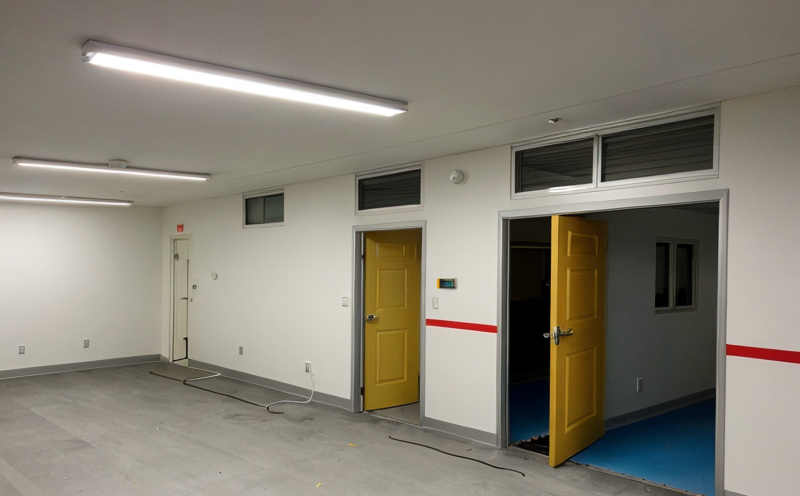IEC 61547 EMC Immunity Testing of Emergency Lighting Equipment
The International Electrotechnical Commission (IEC) standard IEC 61547 is a crucial guideline for the design and testing of emergency lighting equipment. This standard ensures that emergency lights meet strict electromagnetic compatibility (EMC) requirements, which are essential to prevent interference with other electronic devices and ensure safe operation in critical environments.
EMC immunity tests verify whether electrical and electronic equipment can function correctly under specified electromagnetic disturbance conditions. In the context of emergency lighting, these tests are particularly important because they guarantee that safety-critical systems perform reliably even when exposed to various types of interference. This is especially vital for emergency lighting in hospitals, airports, data centers, and other facilities where system failures could lead to severe consequences.
The testing process typically involves exposing the equipment to a range of electromagnetic disturbances, including conducted and radiated emissions, voltage dips, and surges. The aim is to ensure that the emergency lights can withstand these conditions without malfunctioning or causing hazardous situations. This not only enhances product reliability but also ensures compliance with international safety regulations.
The standard provides detailed guidelines on how to conduct EMC immunity tests for emergency lighting equipment. It specifies the types of disturbances, test levels, and acceptance criteria that must be met. By following these procedures rigorously, manufacturers can ensure their products are robust enough to operate safely in complex environments.
EMC testing is crucial because it helps identify potential vulnerabilities in the design before the product reaches market. For instance, if a particular model of emergency lighting fails an EMC test, it indicates that there may be issues with its circuitry or shielding. Addressing these problems early in the development process can save significant costs and time during production.
Moreover, EMC immunity testing ensures consistent quality across different batches of products. It helps manufacturers maintain high standards by providing a standardized method for evaluating their equipment's performance under various interference conditions. This consistency is particularly important given the critical role that emergency lighting plays in ensuring public safety during emergencies.
In summary, IEC 61547 EMC immunity testing is an essential step in the development and certification of reliable emergency lighting equipment. By adhering to this standard, manufacturers can ensure their products meet stringent electromagnetic compatibility requirements, enhancing both safety and performance in critical applications.
Scope and Methodology
The scope of IEC 61547 EMC Immunity Testing for Emergency Lighting Equipment encompasses a wide range of tests designed to evaluate the equipment's ability to withstand electromagnetic interference. These tests are critical for ensuring that emergency lighting can function reliably in environments where other electronic devices may generate electromagnetic noise.
| Test Type | Description |
|---|---|
| Conducted Disturbance Immunity Tests | These tests assess the equipment's ability to operate correctly when exposed to conducted disturbances, such as voltage dips and surges. |
| Radiated Disturbance Immunity Tests | Evaluates how the equipment responds to radiated electromagnetic interference at specific frequencies. |
| Surge Immunity Tests | Tests whether the equipment can continue functioning after being subjected to a sudden increase in voltage or current, simulating lightning strikes or other transient events. |
The methodology for conducting these tests involves setting up controlled environments where the emergency lighting equipment is exposed to predefined levels of electromagnetic interference. The testing process typically follows international standards such as IEC 61547-2 and ANSI/IEEE C1310, which provide detailed procedures for each type of test.
During the conducted disturbance immunity tests, a power supply with an intentional disturbance is used to simulate real-world conditions. For radiated disturbance immunity tests, specialized equipment generates electromagnetic fields over specific frequency bands. Surge immunity tests involve applying high-voltage transients to the equipment's input terminals.
The acceptance criteria for these tests are based on IEC 61547-2 and ANSI/IEEE C1310 standards. Equipment passes if it continues to function correctly within specified limits after being subjected to each type of disturbance. These limits define what is considered acceptable performance under various interference conditions.
By adhering strictly to this scope and methodology, laboratories can ensure that the testing process accurately reflects real-world scenarios while maintaining consistency across different batches of products. This approach helps manufacturers identify potential weaknesses early in the development cycle and improve overall product quality.
Benefits
Ensures compliance with international safety regulations, enhancing public trust.
Improves product reliability by identifying potential vulnerabilities early in the development process.
Maintains consistent quality across different batches of products through standardized testing methods.
Reduces costs and time associated with addressing issues during production.
Enhances safety in critical applications by ensuring emergency lighting can operate reliably even under interference conditions.
Aids in maintaining high standards of performance, contributing to the overall reliability of electrical and electronic systems.
Environmental and Sustainability Contributions
IEC 61547 EMC Immunity Testing for Emergency Lighting Equipment plays a key role in promoting environmental sustainability by ensuring that emergency lighting systems are robust enough to operate reliably under various interference conditions. This contributes to reducing waste associated with product failures and enhancing overall energy efficiency.
By adhering strictly to the EMC testing standards, manufacturers can ensure their products meet strict electromagnetic compatibility requirements, which helps minimize electromagnetic pollution. This is particularly important given the growing concern over environmental degradation caused by electronic devices generating excessive electromagnetic interference.
The reliability of emergency lighting systems is crucial for ensuring public safety during emergencies. By conducting rigorous EMC immunity tests, laboratories help manufacturers produce more reliable and robust products, reducing the likelihood of failures that could compromise safety in critical situations. This contributes to enhancing overall energy efficiency by ensuring that emergency lights function correctly when needed.
In summary, IEC 61547 EMC Immunity Testing for Emergency Lighting Equipment is an essential step towards promoting environmental sustainability. By ensuring reliable and robust products, this testing process helps reduce waste associated with product failures and enhances the overall reliability of electrical and electronic systems, contributing to a more sustainable future.





